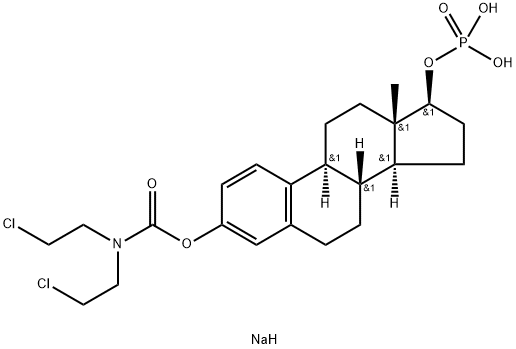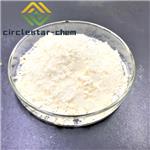Estramustine phosphate is a derivative of estradiol (Item Nos. 20776 | 10006315) that contains a nor-nitrogen mustard group. Estramustine phosphate destabilizes microtubules by binding to microtubule-associated proteins (MAPs) with Kd values of 10 and 15 μM for MAP-1 and MAP-2, respectively. Estramustine induces cell cycle arrest in mitosis at the metaphase stage in DU145 and PC3 prostate cancer cells and induces apoptosis in U87MG human malignant glioma cells. The metabolites of estramustine phosphate have anti-androgenic effects. Formulations containing estramustine phosphate are used in the palliative treatment of prostate cancer.
Estramustine phosphate sodium USP (Emcyt) is used to treat Prostatic carcinoma.
Estramustine sodium phosphate is binds estradiol receptors irreversibly.
ChEBI: An organic sodium salt which is the disodium salt of estramustine phosphate.
Emcyt (Pharmacia & Upjohn).
Estramustine as the phosphate is available in 140-mg capsulesfor the treatment of prostate cancer. Although originallydesigned as an alkylating agent, it has been shown tobe devoid of alkylating activity and functions as an inhibitorof microtubule function by binding to microtubule associate proteins (MAPs) and also binds to tubulin at a site that isdistinct from that of the vinca alkaloids but thought to partiallyoverlap with that of pacilataxel.The major mechanismby which cells become resistant to the agent involvesincreased efflux, although this is not mediated by Pgp as isthe case with other microtubule inhibitors such as the taxanesand vinca alkaloids. Therefore, the agent does not showcross-resistance with these agents. As an inhibitor of microtubules,it is cell cycle specific acting in the M phase. Theagent is well absorbed upon oral administration with hydrolysisof the water solubilizing phosphate beginning to occurin the GI tract. Metabolism involves the formation of theactive estromustine, which arises from oxidation of the C17alcohol to give the ketone. Additional inactive metabolitesresult from carbamate hydrolysis to give estradiol and estrone.The parent and metabolites are primarily eliminatedin the feces with a terminal elimination half-life of 20 hours.The adverse effects of the agent are nausea and vomiting,which is generally mild but the severity may increase uponprolonged administration. Gynecomastia also commonlyoccurs, and diarrhea may also be seen. Less commonly seeneffects include myelosuppression, skin rash, and cardiovascularabnormalities including CHF.



